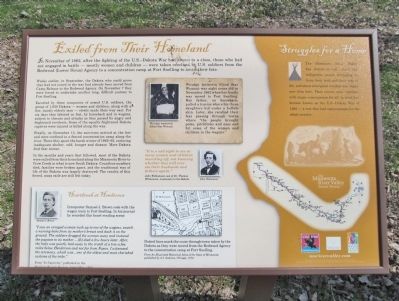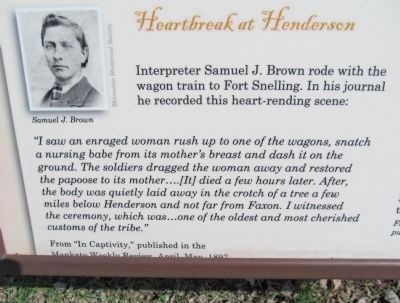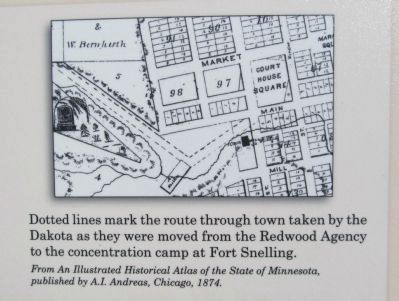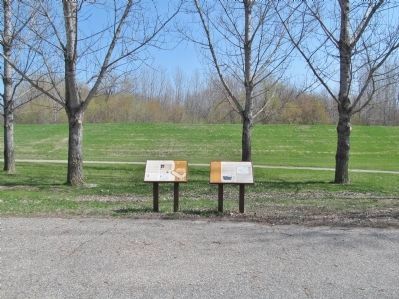Henderson in Sibley County, Minnesota — The American Midwest (Upper Plains)
Exiled from Their Homeland
In November of 1862, after the fighting of the U.S.-Dakota War had drawn to a close, those who had not engaged in battle — mostly women and children — were taken overland by U.S. soldiers from the Redwood (Lower Sioux) Agency to a concentration camp at Fort Snelling to await their fate.
Weeks earlier, in September, the Dakota who could prove they had not joined in the war had already been moved from Camp Release to the Redwood Agency. On November 7, they were forced to undertake another long, difficult journey to Fort Snelling.
Escorted by three companies of armed U.S. soldiers, the group of 1,658 Dakota — women and children, along with a few, mostly elderly men — slowly made their way east. For six days they labored on foot, by horseback and in wagons, subject to threats and attacks as they passed by angry and frightened residents. Some of the equally frightened Dakota captives were injured or killed along the way.
Finally, on November 13, the survivors arrived at the fort and were confined in a fenced concentration camp along the river. There they spent the harsh winter of 1862-63, enduring inadequate shelter, cold, hunger and disease. More Dakota died that winter.
In the months and years that followed, most of the Dakota were exiled from their homeland along the Minnesota River to Crow Creek in what is now South Dakota. Countless numbers died, families were broken apart, and the traditional way of life of the Dakota was largely destroyed. The results of this forced, mass exile are still felt today.
Wicahpi wastewiŋ (Good Star Woman) was eight years old in November 1862 when her family was moved to Fort Snelling. Her father, on horseback, pulled a travois where his three daughters hid under a buffalo skin. Later, she recalled their fear passing through towns where “the people brought poles, pitchforks and axes and hit some of the women and children in the wagons."
"It is a sad sight to see so many women and children marching off, not knowing whether they will ever see their husbands and fathers again."
John Williamson, son of Dr. Thomas Williamson, missionary to the Dakota
Heartbreak at Henderson
Interpreter Samuel J. Brown rode with the wagon train to Fort Snelling. In his journal he recorded this heart-rending scene:
“I saw an enraged woman rush up to one of the wagons, snatch a nursing babe from its mother’s breast and dash it on the ground. The soldiers dragged the woman away and restored the papoose to its mother....[It] died a few hours later. After, the body was quietly laid away in a crotch of a tree a few miles below Henderson and not far from Faxon. I witnessed the ceremony, which was...one of the oldest and most cherished customs of the tribe."
From "In Captivity," published in the Mankato Weekly Review, April-May 1897
(map)
Dotted lines mark the route through town taken by the Dakota as they were moved from the Redwood Agency to the concentration camp at Fort Snelling.
From An Illustrated Historical Atlas of the State of Minnesota, published by A.I. Andreas, Chicago, 1874.
Struggles for a Home
The Minnesota River Valley has stories to tell...about the indigenous people struggling to keep their land and their way of life, and about immigrant families who began new lives here. Their stories came together, with tragic consequences for all, in what has become known as the U.S.–Dakota War of 1862 — a war that had repercussions for the whole country.
logos of: Scenic Byway Minnesota River Valley; Minnesota Historical & Cultural Grants; Clean Water Land & Legacy Amendment
mnrivervalley.com
This project has been made possible by the Arts and Cultural Heritage Fund through the vote of Minnesotans on November 4, 2008. Administered by the Minnesota Historical Society.
Erected 2012 by the Minnesota River Valley National Scenic Byway.
Topics and series. This historical marker is listed in this topic list: Wars, US Indian. In addition, it is included in the Minnesota Historical Society series list. A significant historical month for this entry is November 1862.
Location. 44° 31.912′ N, 93° 54.461′ W. Marker is in Henderson, Minnesota, in Sibley County. Marker is on North 5th Street (County Highway 6) 0.3 miles north of Main Street (State Highway 19), on the right when traveling north. Marker is at the North 5th Street parking lot at Bender Park. Touch for map. Marker is in this post office area: Henderson MN 56044, United States of America. Touch for directions.
Other nearby markers. At least 8 other markers are within walking distance of this marker. The U.S.–Dakota War of 1862 (here, next to this marker); Joseph R. Brown Minnesota River Center (approx. ¼ mile away); A place of big plans and broken dreams... (approx. ¼ mile away); Meet Joseph R. Brown (approx. ¼ mile away); John Other Day (approx. ¼ mile away); August F. Poehler House (approx. 0.3 miles away); St. Jude's Episcopal Church Congregation (approx. 0.3 miles away); Veterans Memorial (approx. 0.3 miles away). Touch for a list and map of all markers in Henderson.
More about this marker. captions:
• Wicahpi wastewiŋ (Good Star Woman) Minnesota Historical Society
• John Williamson
Minnesota Historical Society
• Samuel J. Brown Minnesota Historical Society
Regarding Exiled from Their Homeland. In August 1862, the Minnesota Dakota, also known by the French term, “Sioux," waged war against the United States following two years of unfulfilled treaty obligations. After attacking the Redwood (Lower Sioux) Agency, a remote government outpost, the Dakota moved with speed and surprise throughout southwestern Minnesota and what was then eastern Dakota Territory, killing nearly everyone in their path.
868 men, women, and children perished by actual count. Those killed whose remains were never found and the soldiers and citizens killed or mortally wounded in the hostile engagements with the Indians made the total death list number at least 950.
source: Monuments and Tablets Erected by the Minnesota Valley Historical Society, 1902
Also see . . .
1. The U.S. - Dakota War of 1862. Minnesota Historical Society website entry (Submitted on May 10, 2014.)
2. Minnesota River Valley Scenic Byway. Byway website homepage (Submitted on May 10, 2014.)
Credits. This page was last revised on June 2, 2023. It was originally submitted on May 10, 2014, by Keith L of Wisconsin Rapids, Wisconsin. This page has been viewed 531 times since then and 13 times this year. Photos: 1, 2, 3, 4. submitted on May 10, 2014, by Keith L of Wisconsin Rapids, Wisconsin.



